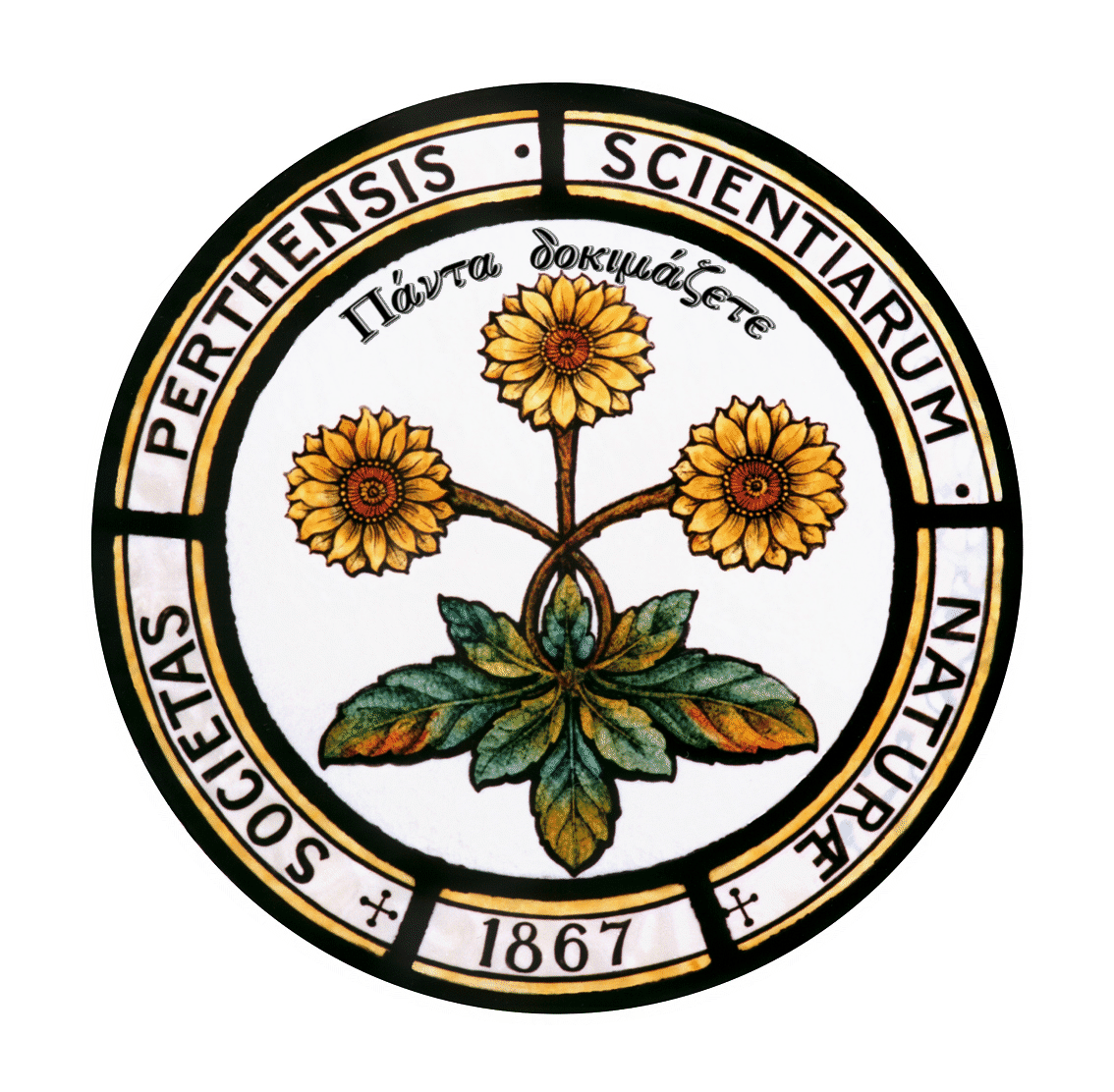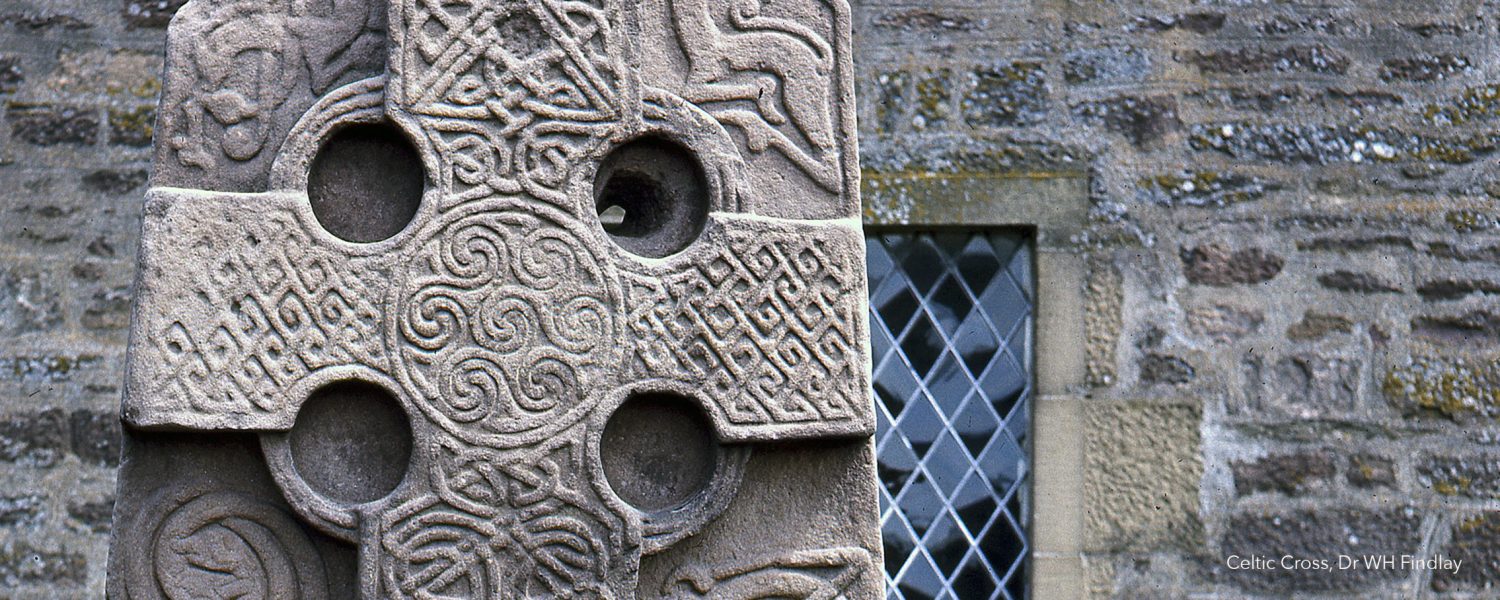Author Archives: PSNS Secretary
Video Talk – 40 years of monitoring rare arctic-alpine plants on Ben Lawers
by Sarah Watts, Ecologist and Conservation Manager.
Sarah is a plant ecologist with a strong focus on upland vegetation, restoration ecology and applied science. She is the Conservation Manager of Corrour in the Scottish Highlands and is currently researching her part-time PhD entitled “Improving outcomes in montane woodland restoration”. From 2013-2020 she worked as an ecologist for the National Trust for Scotland at Ben Lawers NNR.’
Curious Minds and Section Videos
Missed a CM or Section talk because you had something else to do? Now you can have the best of both worlds.
Click this link for PSNS Curious Minds Recorded Talks
Click this link for PSNS Archaeology and History Recorded Talks
Click this link for PSNS Ornithology and Botany Recorded Talks
Ornithology Newsletter Nov 2021
Curious Minds is Back – Season 6 – 2021/22
Curious Minds is back – with an even bigger and better programme of live talks in the Soutar Theatre PLUS simultaneous participation by Zoom from the comfort of your own home.
The live talks and Zoom are open to the general public. To start with, we are limiting the numbers of live attendees to well below the Covid guidelines. That will be constantly reviewed. But there is no limit on Zoom participation. Tickets for the live events, and for Zoom, will be available on the Culture Perth & Kinross website at www.culturepk.org.uk/curiousminds6
See our Curious Minds page for full details of all the talks.
40 Years of Change and A Year of Covid – Share Your Thoughts
Dear Member,
This is a request for your thoughts and observations on how the world has changed locally since the 1980’s (or earlier) and/or how Covid has affected the pursuit of your interests and its impact on the natural world locally.
The subjects currently being worked on range from photographic techniques, ecology, climate, access and storage of social archives, to what we see on our daily walk.
Photographs, audio recordings, self recorded Zoom, short videos, scanned scribbles, sketches, artwork – they are all welcome, from rants to more measured and researched thoughts.
What will be done with them? At the very least they will be put in a 2020/21 Folder and archived for future generations. The archive will be linked to the PSNS website for ease of access. Anonymity can be arranged, copyright protected.
A few members have already written articles. Some are short, simply presented as a few paragraphs. Others are longer, some showing off excellent desktop publishing skills.
For some examples from differing ends of the spectrum, click here.
Margaret Borland-Stroyan, David Perry, Jeff Banks, Malcolm Lind, John Jessop, Clare Scanlon, Frances Whittet, and Roben Antoniewicz are all available to help.
We hope you can see the pleasure that a wide range of topics and styles will bring to our fellow and future members as well as promoting the Society to the wider public.
David Bowler
President
secretary@psns.org.uk
Draft Minutes of 154th AGM of PSNS 7pm 26th March 2021on Zoom
These are being reviewed by Council and will shortly be circulated to all members by email. The minutes and the associated reports are available, to members only, from the Secretary upon request.
Bird Supersense Recording Friday 19th Feb 2021
On Friday 19 Feb 2021, our own Jeff Banks kick-started the first of a series of mini-Curious Minds lectures, on the subject of “A Bird Supersense” – studies into the Herbst corpuscules at the tip of wading birds’ beaks.
The video is available on youtube:
Photography in the PSNS – from Analogue to Digital
My Patch Over the Years
Living as I have done for over 25 years in Craigie above Clunie loch, my patch stretches from the Lunan Valley to the River Tay. I have taken part in many surveys, mainly for the BTO, and when at home on New Year’s Day have birdwatched from dawn to dusk noting all the bird species seen. One thing is clear, there are now fewer birds of all sorts than there were 20 to 25 years ago. Farming practices will have a lot to do with that but there are probably other reasons such as climate change that are out with local activities.
Waders have all but disappeared. Yet on 10 May 2000 on a short walk from my house we saw 4 sitting Lapwing, plus 2 in display flight, and 7 others. Last year, 2020, there were none. Within walking distance of the house we could find breeding Curlew, Lapwing, Oystercatcher, and Redshank. In the past two years no more than a pair each of Lapwing and Oystercatcher have between seen in the summer.
My Millennium walk on 1 January 2000 occurred on a dry day with a bright start becoming cloudy, but with good visibility all day. Everywhere was frozen to ice, smooth on the road, ankle-twisting bumpy in the fields. I viewed the birds from the kitchen window as I ate breakfast and left the house at 0915, finding a Snipe in a boggy pool, before heading down to Clunie Loch, which was 90-95% frozen over. There were still 60 Cormorants at the roost in trees on the island. The first of many Buzzards appeared (I saw 19 in all that day). On and around the small patch of open water there were 100 Mallard, 22 Tufted, c. 20 Teal, m12 Wigeon, 4 Pochard and a few Coot. Then over fields to the old footbridge below Forneth, up across the public road to the fields above Forneth House and down by Wester and Easter Tullyneddie to New Mill on the Lunan which I crossed by the old eel dam, and thence to Drumellie loch. Here, I was rewarded by a nice party of Long-tailed Tits and 3 Goosander. Somewhat birdless fields on the way to Drumbeltie where in the”secret” pool in the wood I found a Grey Heron and a Mute Swan.
Over fields that had been flooded to the Tay opposite the Marsden hide and then along the bank to beyond Garden Cottage. The river here held a few Goldeneye, Herring and Great Black-backed Gulls. I persisted and went out onto the shingle banks beyond the cottage. Here, I was delighted/surprised by, first, a Greenshank, and then one and then a second Green Sandpiper. With the day fading I was lucky to pick up a Treecreeper and a Grey Partridge on Delvine estate.
The early part of the day was notable for numerous small to medium flocks of small farmland birds – especially attracted to the rape and weedy set-aside and game cover fields. There were two nice parties of Skylarks. Finch highlights were two Bramblings in the upper fields and c.50 Reed Buntings above Lethendybank. The days total of 55 species included 3 introduced species, Pheasant, Red-legged Partridge and feral Pigeon.
The following year, the walk covered similar ground, melting snow making for slow progress, with the same species total. However there were 9 species seen in 2000 and not in 2001, making it 64 over the 2 years, and I missed some Waxwings that a neighbour saw! An excerpt from my diary for that day records that the roadside hedges were alive with small birds, Yellowhammers, Greenfinches, Tree Sparrows, Reed Buntings and Fieldfares. A chirruping flock of about 30 Skylarks passed over.
Fast forward to January 2019 and 2021. Much the same country was covered, but age was taking its toll and some of the less, productive sections were missed and the walk split into sections with a return to base in between. The weather was mild in 2019, but in 2021 ground was again frozen. However, the hedges held only a handful of small birds, and even in the garden there were fewer. So, over these two years, the total was just 45 species, with big losses among the passerines on the farmland, hedges especially, and with the waterbirds. Changes in farming practices are almost certainly responsible for the disappearance of the small birds. And warmer winters are probably responsible for the much smaller numbers of wintering wildfowl who have discovered that they no longer need to leave northern lands to find open water in the winter. This current winter may turn out to be colder than those preceding. It will be interesting to see if waterbird numbers approach those of 20 years ago.
Late summer 20 years ago would see 60 to 100 hirundines gathering on electricity lines outside the house, particularly House Martins. In recent years there have been only 3 or 4 House Martin nests in the hamlet, which have had mixed success, Swallows likewise, so that post-breeding gatherings are now in the low teens. Coinciding with the drastic reduction in rabbit numbers due to myxomatosis Buzzard pairs have reduced from about 7 within a mile of the house to 3 to 4. We now see no Kestrels, but Sparrowhawks still raid the wee birds in our gardens.
The one big plus has been the increase in Osprey numbers in Perthshire, with one pair breeding on Clunie Loch every year since 2017, and raising 6 young in total.
David Merrie
January 2021
2021 Looking Forward : Looking Back
From a time of pandemic, members look back over their time in PSNS and think about the future. Please contribute as well. Here’s how.
Looking Back:
Ornithology and Botany
- Bird Watching and the Birds of Perth and Kinross: A record of change – Jeff Banks (2021)
- My Patch Over the Years – (..last year…there were none…) – David Merrie (2021)
- Perthshire Birdwatching in 1961-65 – A comparison with 2020 – David Merrie (2021)
- 40 years of monitoring rare arctic-alpine plants on Ben Lawers NNR – Sarah Watts Ecologist and Conservation Manager (2022)
Photography
- Photography in the PSNS – from Analogue to Digital – Roben Antoniewicz (2021)
History and Archaeology
- Statistical Accounts, treasure trove for local historians – Margaret Borland-Stroyan (2021)
- Perthshire Since 1970 – a statistical update – David Perry (2021)
Reflections
- Dance of the Deer – Malcolm Lind (2021)
- Why Do I Compose Stories? – Malcolm Lind (2021)
- The Secretary’s View of 2020+ – John Jessop (2021)
2017: The 150th Anniversary of PSNS
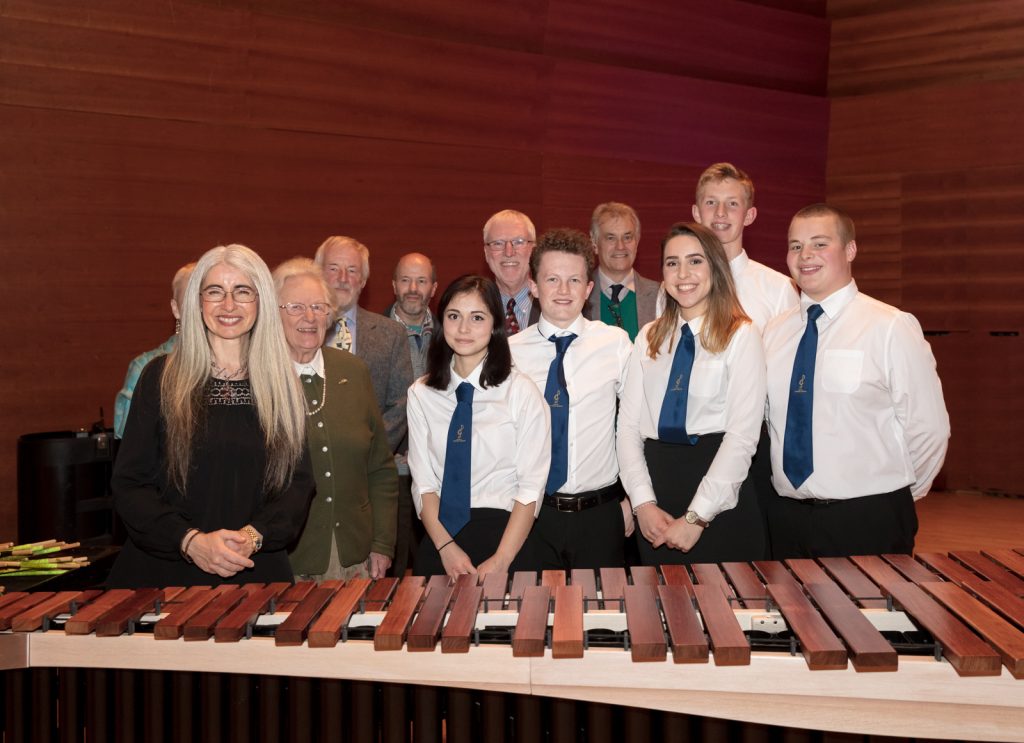
150th Anniversary events
The Botanical Section invited the Radio Scotland Out of Doors programme to the Birks of Aberfeldy to interview the Section’s dandelion expert.
Dame Evelyn Glennie concert and talk
First Season of Curious Minds winter season talks
PSNS exhibition and reception in Perth Museum and Art Gallery
PPS Photography Exhibition in 2 High Street. The Photographic Section curated an exhibition of members’ photographs from the Society’s earliest days up to the present.
Colin Prior lecture in St Matthews
2016 – Curious Minds Lecture Series
Curious Minds – An Idea is Hatched
From its beginnings in the 19th Century, PSNS ran a series of Friday evening lectures for members and their guests. The talks were originally held in the Society’s own museum on Tay Street but, when the PSNS collections were gifted to the new Perth Museum in 1935, the meetings moved to the museum lecture theatre. Talks featured speakers from the Society’s active sections, the Perth Mountaineering Club (an early PSNS spin-off) and guests from other learned societies. Many speakers presented research on the natural history and archaeology of Perthshire that would go on to be published in academic journals.
Fast forward to 2015. As PSNS approached the 150th anniversary of its founding the era of the amateur scientist was long gone. The society had stopped publishing its own Journal. Friday night lectures still featured on the agenda but attendance numbers had declined. PSNS had to decide what its role was in modern Perth? Round about the same time, Perth Museum was undergoing a similar period of change with the formation of Culture Perth and Kinross.
PSNS met with the new CPK management and the idea for a collaboration was hatched. CPK and PSNS would work together to bring contemporary, cutting-edge science, from Scottish Universities and Laboratories, to the people of Perth. PSNS would provide the speakers and organize the events. CPK would help with marketing and technical support. Curious Minds was born. The talks would be open to the general public, to schools, to college students. They would reflect local interests, when appropriate, but they would also tackle some of the most advanced and ground breaking research being conducted in Scotland.
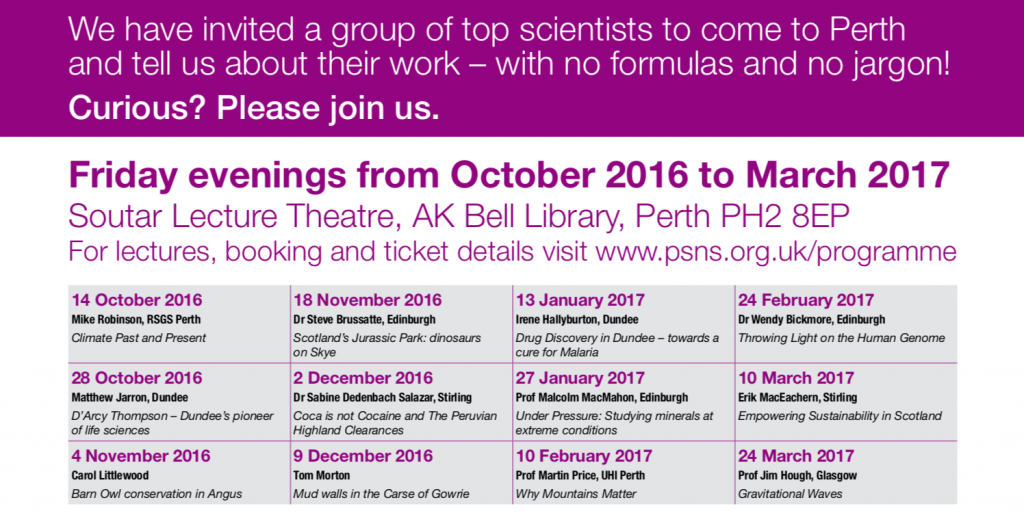
The first season of 12 talks kicked off in October 2016 and was an immediate success. Our first speaker was a safe choice. Mike Robinson is a well-known local figure as CEO of the Royal Scottish Geographical Society. His subject was also a safe choice. Climate change. We quickly developed a structure for the evenings. Our speaker would talk for up to 1 hour. We break for tea and coffee then re-convene for a Q&A session that developed into a genuine audience discussion. Often, this was the highlight of the evening. Our audience quickly stabilized at around 100 people – with regular capacity crowds. It would take too long to describe all of the lectures so let’s just pull out a number of highlights. In November 2016 we were lucky to entice the World-famous palaeontologist, Dr Steve Brussatte, to come to Perth and show us his most recent discoveries – dinosaur footprints on Skye. Steve was welcomed by the Provost of Perth and, of course, his talk had something for everyone from the serious fossil buffs to families with kids clutching their favourite dinosaur toys.
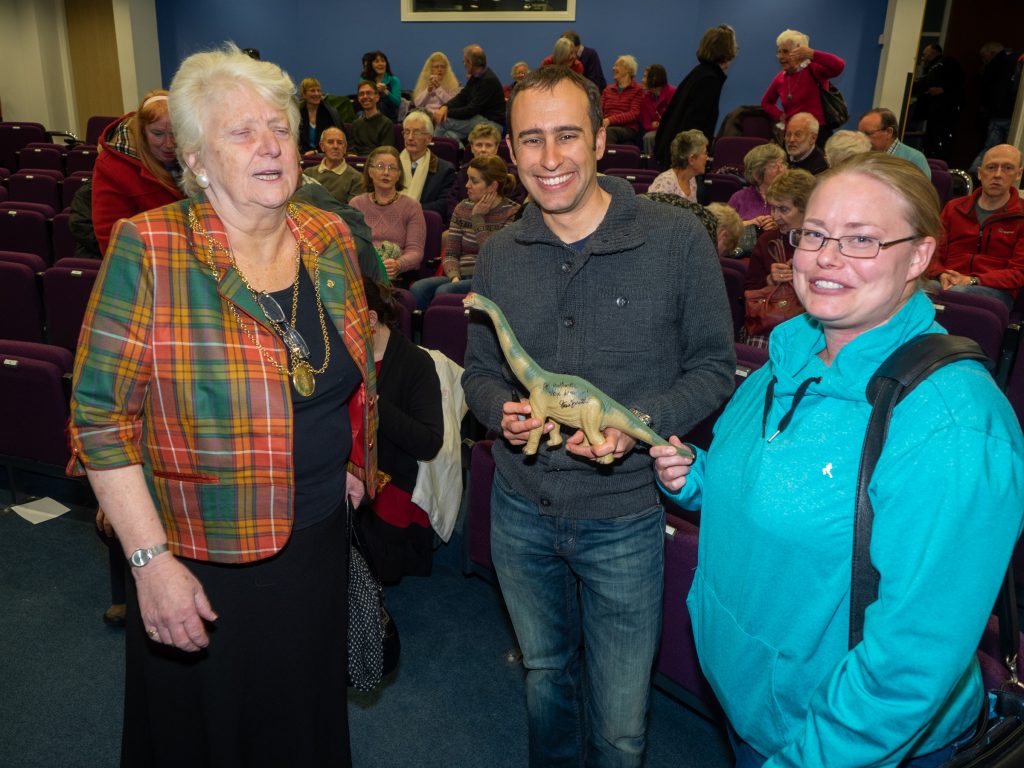
In February we turned the science knob up to 11 with Professor Wendy Bickmore, Director of the MRC Human Genetics Unit in Edinburgh who gave us a guided tour of the human genome. But the final talk of the year will never be forgotten. Professor Jim Hough, from Glasgow, is a long-term collaborator on the LIGO project to detect Gravitational Waves. Jim was literally on his way home from the USA when he gave a talk in Perth. He brought with him his laptop which had, on it, the first recording of the “sound” of a gravitational wave. 120 people, in a lecture theatre in Perth, were among the first to hear the “chirp” of two black holes colliding!
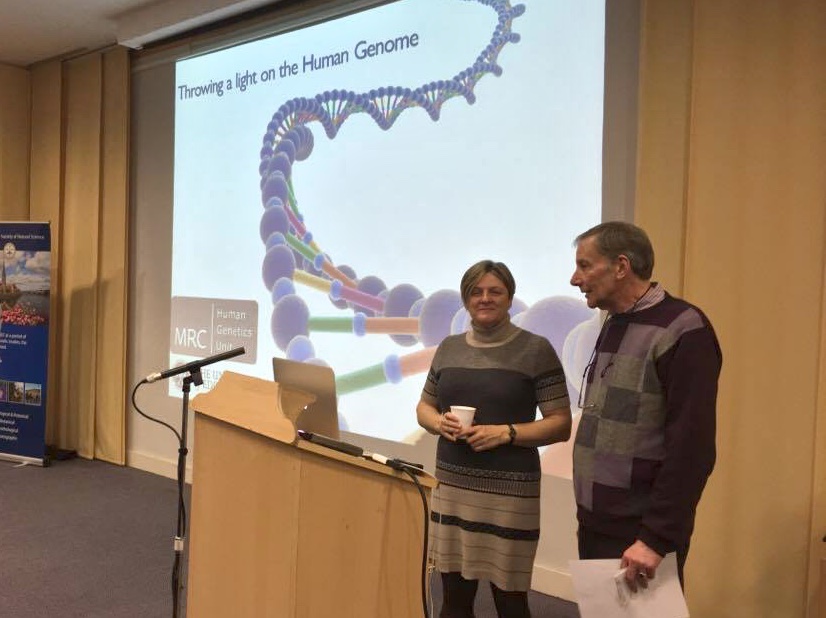
Season 2: The PSNS 150th Anniversary

In the Autumn of 2017 the Society organized several events to mark its150th anniversary. (Link to another article). We invited Dame Evelyn Glennie to open our second Curious Minds season. Dame Evelyn overcame profound deafness to become a World famous percussionist. She brough along her musical instruments and explained, and demonstrated, how she feels music through her body. Remarkable and inspirational. She was joined on stage by members of the Perth Youth Percussion ensemble.
The second season built on the first with a similar mix of local and global topics ranging from archaeology (the search for the tomb of James I under Perth), through the physiology of seals in the Tay, to Vulcanology in Iceland to the discovery of the Higgs Boson in CERN. The Higgs Boson talk filled the auditorium to overflowing. Victoria Martin, from Edinburgh, works at CERN and was both a student and colleague of Professor Peter Higgs. Before the talk we told her “Don’t dumb it down” – and she didn’t. But the reaction was amazing. At the interval she was immediately surrounded by school students eager to ask her questions. She was like a – rock star.
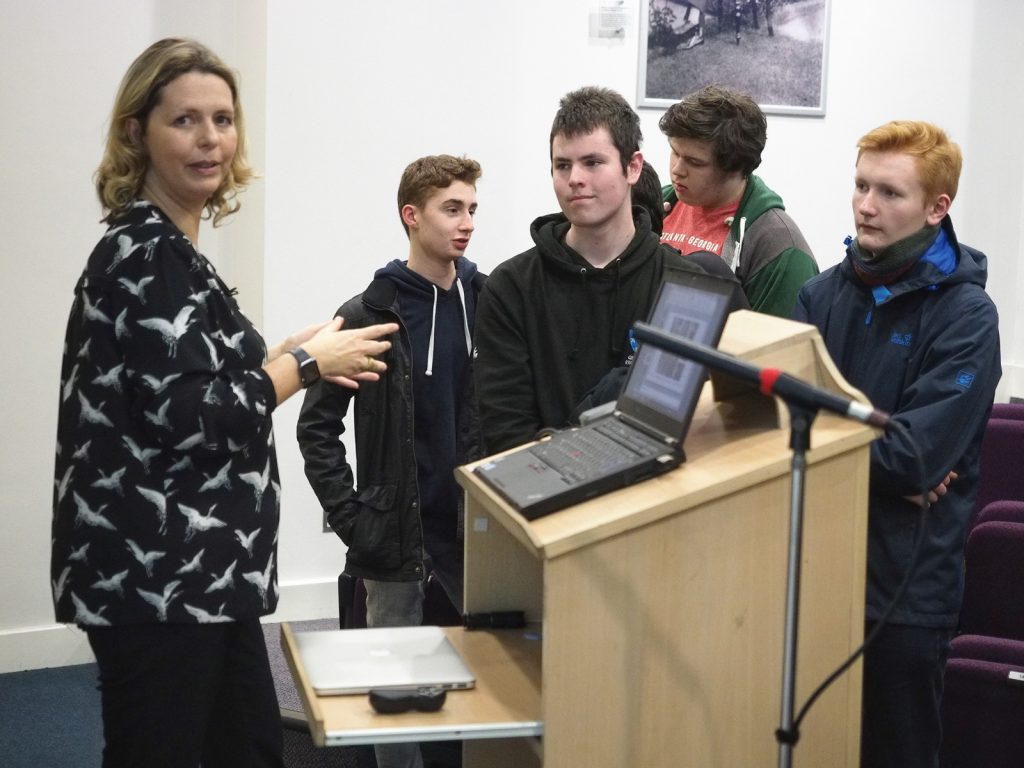
But don’t get the impression that Curious Minds is all about sub-atomic particles or impenetrable formulae. Far from it. Our next talk was by a local Perth artist and musician, Jon Hoad. Remarkably, from his studio in central Perth, Jon produces illustrations of Dinosaurs in their Jurassic environments. Jon creates images for Museums, publishers and for Steve Brussatte. We were treated to an update on the Skye footprints project with musical accompaniment from Jon on his guitar.
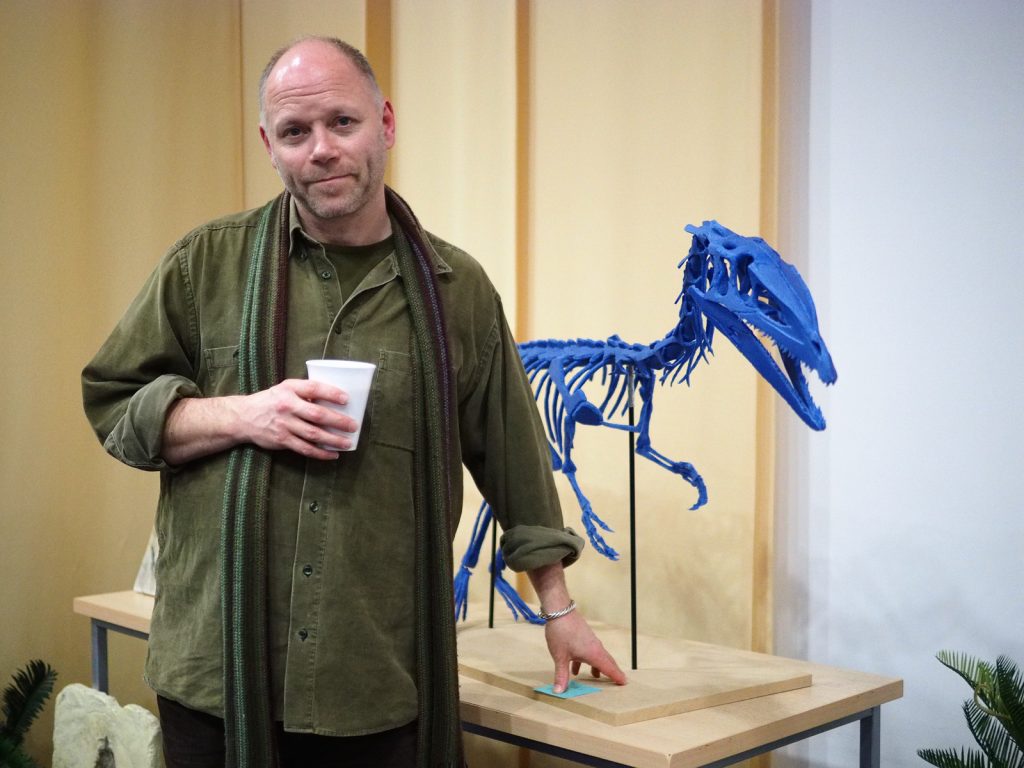
Season 3: 2018/19 – In Our Stride
Season 3 confirmed that we were really hitting our stride. Word of the lecture series had spread through the Scottish Academic community. Speakers didn’t have to be persuaded to travel to Perth on dark Winter evenings. We began the season with a “close to home” talk by Dr Alison Sheridan of the National Museum of Scotland. The PSNS Archaeology and History Section was set up in 1948 and Alison’s lecture marked its 70thanniversary. She described how, 5000 years ago, beautiful jadeite axe heads were quarried from a rock high in the Italian Alps and, eventually, turned up in a farmer’s field in Perthshire. A remarkable detective story.
The season continued the eclectic mix that we established over the previous years. We heard about searching for exoplanets, the causes (and cures?) for dementia, Gorilla communication, the physics of musical instruments and more.
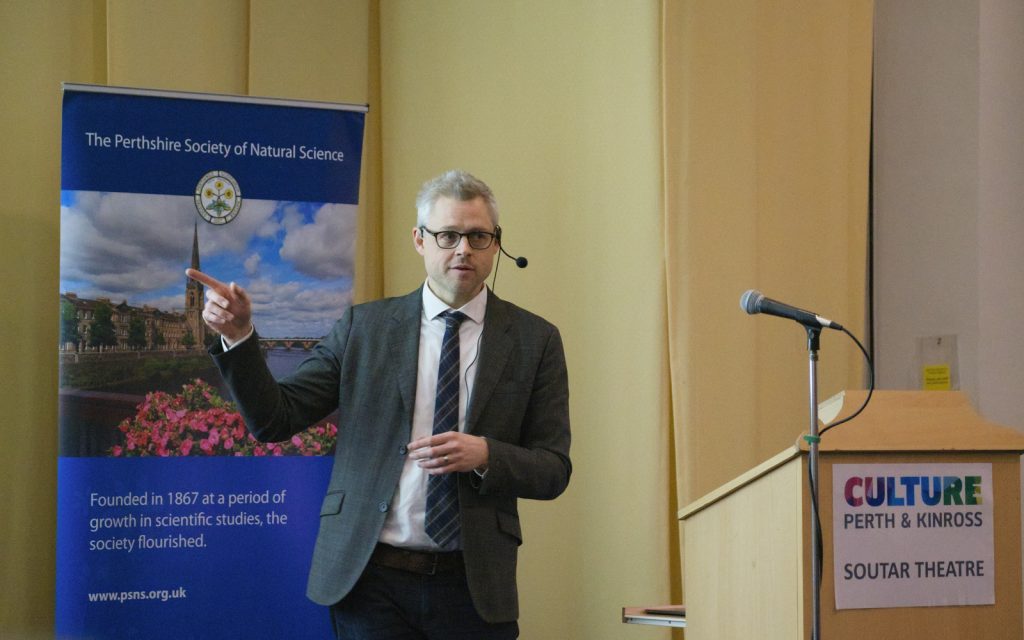
One highlight was a talk by Professor Luke Bisby on Fire Engineering. Luke had been involved in studying the World Trade Centre after the 9/11 attacks. Why did the buildings collapse? He and his team modelled how the build up of heat melted and buckled key structural components – with catastrophic consequences. Luke also contributed to the expert report on the Grenfell fire. A fascinating evening – made more memorable by the arrival of the active-duty fire crew from Perth Fire Station – in full uniform – complete with fire engine in the car park!
Season 4: 2019/20 – Consciousness and Covid
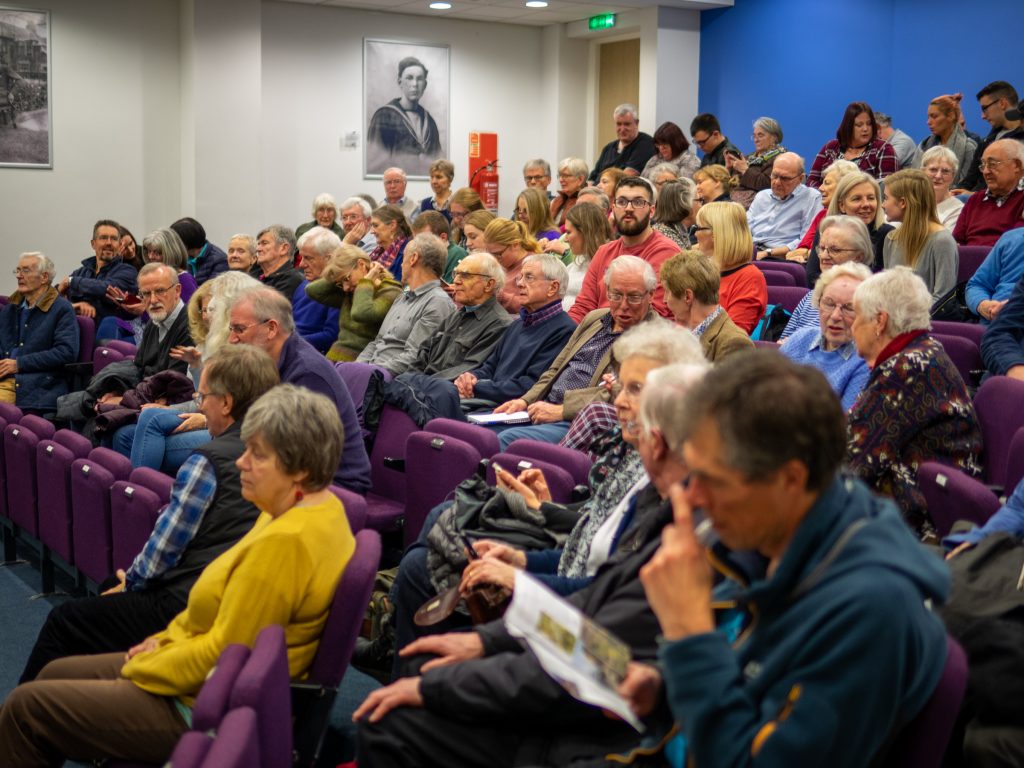
By the time season 4 came around in 2019 we were confident in our format and we began to broaden the range of topics that we felt would be of interest to our audience. In addition to some great mainstream science talk covering subjects like antimicrobial resistance, to engineering in space and radiocarbon dating, we enjoyed a talk from Professor Bruce Whitelaw of the Roslin Institute on the gene-editing technology, CRISPR. We also included talks to explore subjects such as sensory perception, Artificial Intelligence, optical illusions and, the big unanswered question “What is consciousness?”. Professor Michael Wheeler is a Philosopher from Stirling who had stepped in at the last moment in Season 3 when one of our speakers cancelled. Mike introduced us to his own work “The Extended Mind”.
He talked about the relationship between our mental processes and the tools that we increasingly use to interact with the external world. We asked Mike to come back and talk about Consciousness. At first, he was reluctant. It is a difficult and contentious subject. But he agreed to come along and give us a neutral view of current ideas on the subject. The auditorium was completely sold out. This is clearly an interesting subject. Mike gave a great and clear explanation and, eventually, hinted at his own belief.
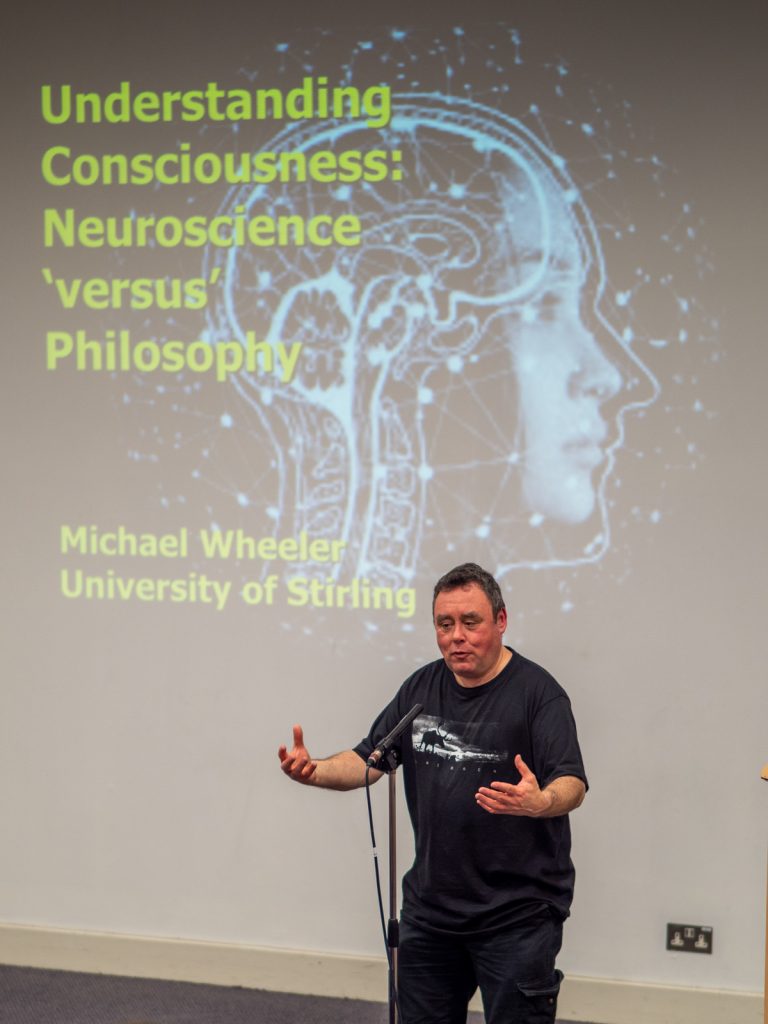
Our final Curious Minds lecture explored another new direction for PSNS. Professor Aude le Guenec, a fashion anthropologist, talk about how a parent’s choice of children’s clothing influences their social and emotional development. That was on March 6th 2020. A few days later our World changed as Covid-related restrictions made such events impossible. 2020/21 was a wash out. We look forward to Season 5 when it becomes possible with, we promise, no talks on viruses, vaccines or pandemics!
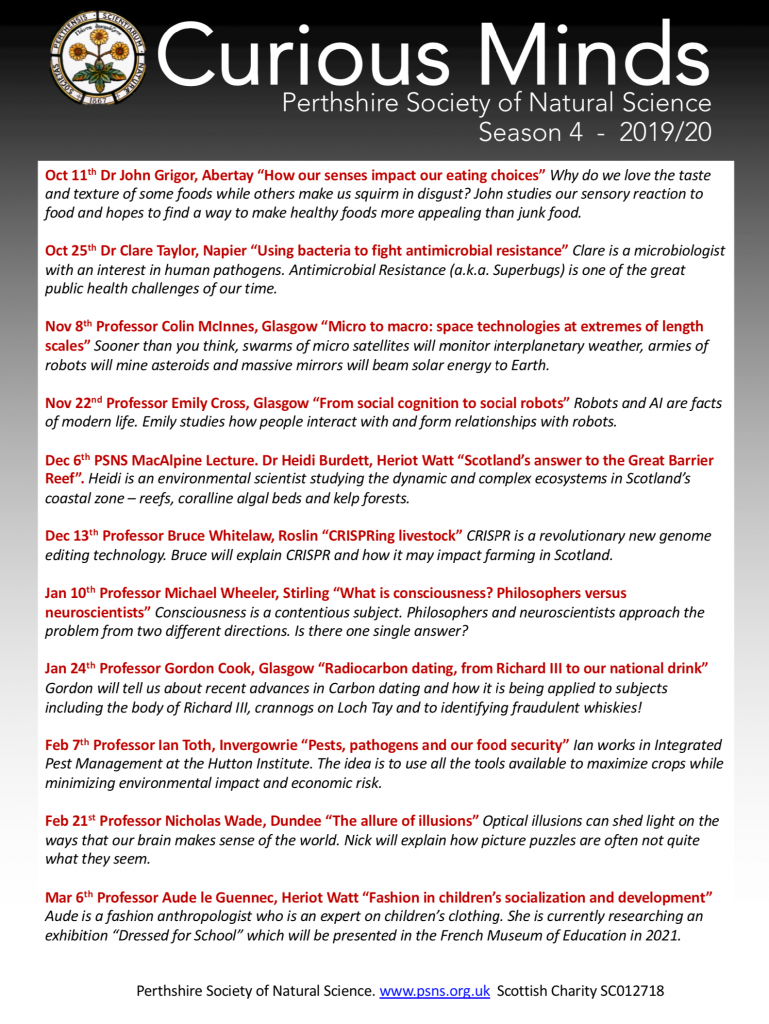
PSNS People 1980’s – 2020
Open to all, the Society’s sections continued to explore, record and influence the world around them, supporting initiatives such as the Tay and Fife Archaeological Committee and networking with like minded organisation. Extensive photographic, botanical, and ornithological records were published during this period.
The PSNS kept active in local affairs and education due largely to the work of Roda Fothergill.
Dr Margaret Stewart MBE (1907 – 1986), Valerie McLaren Thom (1929 – 1998), James Aitken (1913 – 2003), Dr WH Findlay (1911 – 2006), Kenneth M MacAlpine (1908 – 1994), Rhoda Fothergill BEM
1990’s A Social Record – Rhoda Fothergill publishes historical guides to Perth

Perhaps the longest serving PSNS member – ever – Rhoda Fothergill became Secretary of the Society in 1968 and remained so for 47 years. Rhoda studied in Edinburgh, St Andrews and Dundee, but lived most of her life in Perth. She taught in Caledonian Road School, and before that in Kinnoull School. Her interests covered all the activities of the Society but she was a tireless researcher into the archaeology and history of Perth and its people. In her school teaching days she often recruited her pupils into her studies. A project on The Vennels of Perth led to an art project to decorate one of the vennels with information on the crafts and trades of the burgh. Many of her booklets, for example on the Charterhouse, began as class projects. She was a prolific writer of papers and booklets. Some found their way into the Society’s Journal, and some are now being re-published on the PSNS web site. She was a tireless supporter of the Society’s School Essay competitions.
She was a popular lecturer on Old Perth, on the Greyfriars Burial Ground, and on some of the notable characters of the 19th-century burgh. Her lectures were often given under the auspices of Perth College. She also led guided walks, around Greyfriars and various parts of Perth, often connected with the Civic Trust.
Her contribution was recognised not only locally but also nationally. For several years she served on the Ancient Monuments Board, and in 2014 she received the British Empire Medal for her contribution to the history and preservation of Perth and Perthshire.
